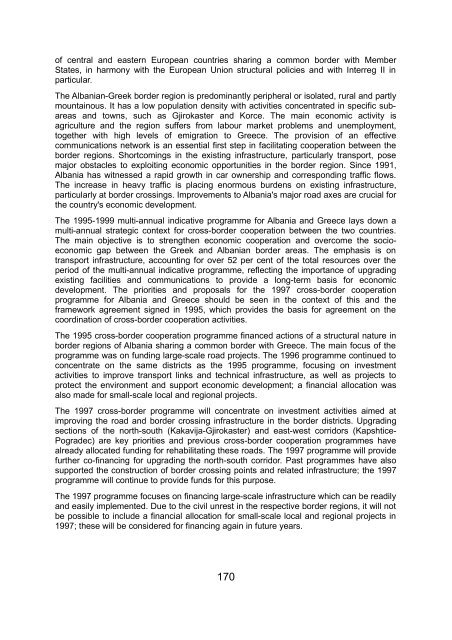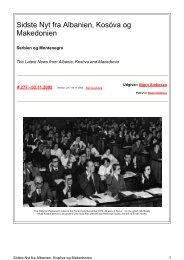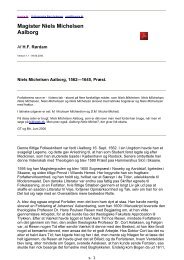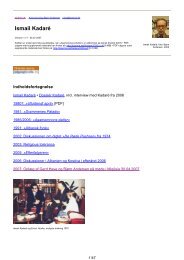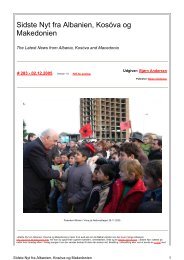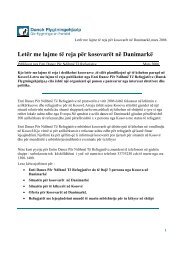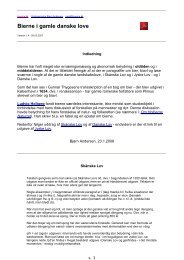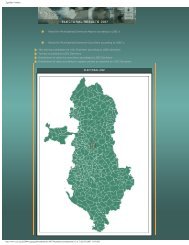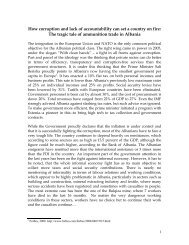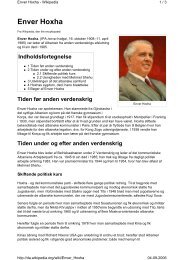Krudttønden i baghaven 1999, digital version 2010 - BA Forlag
Krudttønden i baghaven 1999, digital version 2010 - BA Forlag
Krudttønden i baghaven 1999, digital version 2010 - BA Forlag
You also want an ePaper? Increase the reach of your titles
YUMPU automatically turns print PDFs into web optimized ePapers that Google loves.
of central and eastern European countries sharing a common border with Member<br />
States, in harmony with the European Union structural policies and with Interreg II in<br />
particular.<br />
The Albanian-Greek border region is predominantly peripheral or isolated, rural and partly<br />
mountainous. It has a low population density with activities concentrated in specific subareas<br />
and towns, such as Gjirokaster and Korce. The main economic activity is<br />
agriculture and the region suffers from labour market problems and unemployment,<br />
together with high levels of emigration to Greece. The provision of an effective<br />
communications network is an essential first step in facilitating cooperation between the<br />
border regions. Shortcomings in the existing infrastructure, particularly transport, pose<br />
major obstacles to exploiting economic opportunities in the border region. Since 1991,<br />
Albania has witnessed a rapid growth in car ownership and corresponding traffic flows.<br />
The increase in heavy traffic is placing enormous burdens on existing infrastructure,<br />
particularly at border crossings. Improvements to Albania's major road axes are crucial for<br />
the country's economic development.<br />
The 1995-<strong>1999</strong> multi-annual indicative programme for Albania and Greece lays down a<br />
multi-annual strategic context for cross-border cooperation between the two countries.<br />
The main objective is to strengthen economic cooperation and overcome the socioeconomic<br />
gap between the Greek and Albanian border areas. The emphasis is on<br />
transport infrastructure, accounting for over 52 per cent of the total resources over the<br />
period of the multi-annual indicative programme, reflecting the importance of upgrading<br />
existing facilities and communications to provide a long-term basis for economic<br />
development. The priorities and proposals for the 1997 cross-border cooperation<br />
programme for Albania and Greece should be seen in the context of this and the<br />
framework agreement signed in 1995, which provides the basis for agreement on the<br />
coordination of cross-border cooperation activities.<br />
The 1995 cross-border cooperation programme financed actions of a structural nature in<br />
border regions of Albania sharing a common border with Greece. The main focus of the<br />
programme was on funding large-scale road projects. The 1996 programme continued to<br />
concentrate on the same districts as the 1995 programme, focusing on investment<br />
activities to improve transport links and technical infrastructure, as well as projects to<br />
protect the environment and support economic development; a financial allocation was<br />
also made for small-scale local and regional projects.<br />
The 1997 cross-border programme will concentrate on investment activities aimed at<br />
improving the road and border crossing infrastructure in the border districts. Upgrading<br />
sections of the north-south (Kakavija-Gjirokaster) and east-west corridors (Kapshtice-<br />
Pogradec) are key priorities and previous cross-border cooperation programmes have<br />
already allocated funding for rehabilitating these roads. The 1997 programme will provide<br />
further co-financing for upgrading the north-south corridor. Past programmes have also<br />
supported the construction of border crossing points and related infrastructure; the 1997<br />
programme will continue to provide funds for this purpose.<br />
The 1997 programme focuses on financing large-scale infrastructure which can be readily<br />
and easily implemented. Due to the civil unrest in the respective border regions, it will not<br />
be possible to include a financial allocation for small-scale local and regional projects in<br />
1997; these will be considered for financing again in future years.<br />
170


